[Broadway Ad Network]
[Broadway Ad Network]

TICKET / INFO
- StudentRush
- New York Show Tickets
- Givenik.com
- Telecharge.com
- Ticketmaster.com
- Group Sales Box Office
- Frugal TheaterGoer
- Broadway for Broke People
- Playbill's Rush/Lottery/SR
- Seating Charts
COMMUNITY
NEWS
- Back Stage
- Bloomberg
- Broadway.com
- BroadwayWorld
- Entertainment Weekly
- NYTheatre.com
- New York Magazine
- The New York Daily News
- The New York Post
- The New York Times
- The New Yorker
- Newsday
- NiteLife Exchange
- Playbill
- Show Business Weekly
- The Star-Ledger
- Talkin'Broadway
- TheaterMania.com
- Time Out New York
- American Theatre Magazine
- Theatre Development Fund (TDF)
- Best of Off-Broadway
- The Village Voice
- Variety
- The Wall Street Journal
- Journal News
REVIEWS
- The New York Times
- Variety
- New York Post
- NY1
- Aisle Say
- CurtainUp
- DC Theatre Scene
- Show Showdown
- Stage and Cinema
- StageGrade
- Talk Entertainment
- TotalTheater.com
- Off-Off Broadway Review
- TheaterOnline.com
- TheaterScene.net
- TheaterNewsOnline.com
WEST END
- The Stage
- 1st 4 London Theatre Tickets
- Book Your Theatre Tickets
- Compare Theatre Tickets.co.uk
- Theatre.com
- Whatsonstage.com [UK]
- ATW - London
- Musical Stages [UK]
- Albemarle of London
- Londontheatre.co.uk
- Google News
- Show Pairs
- ILoveTheatre.com
- The Official London Theatre Guide
- UK Tickets
BOSTON
CHICAGO
LA/SF
COLUMNS
- Peter Bart
- Andrew Cohen
- Ken Davenport
- Tim Dunleavy
- Peter Filichia
- Andrew Gans
- Ernio Hernandez
- Harry Haun
- Chad Jones
- Chris Jones
- James Marino
- Joel Markowitz
- Matthew Murray
- Michael Musto
- Ellis Nassour
- Tom Nondorf
- Richard Ouzounian
- Michael Portantiere
- Rex Reed
- Michael Riedel
- Frank Rizzo
- Richard Seff
- Frank Scheck
- Mark Shenton
- John Simon
- Robert Simonson
- Steve on Broadway (SOB)
- Steven Suskin
- Terry Teachout
- Theater Corps
- Elisabeth Vincentelli
- Hedy Weiss
- Matt Windman
- Linda Winer
- Matt Wolf
PODCAST
RADIO
TV
- Theater Talk
- BlueGobo.com
- Classic Arts Showcase
- American Theatre Wing Seminars
- Women in Theatre
- NY1
- WCBS [2]
- WNBC [4]
- FOX [5]
- WABC [7]
- WWOR [9]
- WPIX [11]
- Channel 13
- Hulu
- YouTube
AWARDS
- Tony Central
- Oscar Central
- Tony Awards
- Drama Desk Awards
- The Drama League Awards
- Lortel Awards
- Academy Awards
- Emmy Awards
- Grammy Awards
- GoldDerby
DATABASE
- Internet Broadway Database
- Internet Off-Broadway Database
- Internet Movie Database
- Internet Theatre Database
- Musical Cast Album Database
- [CastAlbums.org]
- Show Music on Record Database (LOC)
- CurtainUp Master Index of Reviews
- Musical Heaven
- StageSpecs.org
ROAD HOUSES
- Gammage [AZ]
- Golden Gate [CA]
- Curran [CA]
- Orpheum [CA]
- Community Center [CA]
- Civic [CA]
- Ahmanson [CA]
- Pantages [CA]
- Temple Hoyne Buell [CO]
- Palace [CT]
- Rich Forum [CT]
- Shubert [CT]
- Bushnell [CT]
- Chevrolet [CT]
- Broward Center [FL]
- Jackie Gleason [FL]
- Fox [GA]
- Civic Center [IA]
- Cadillac Palace [IL]
- Ford Center/Oriental [IL]
- The Bank of America Theatre [IL]
- Auditorium Theatre of Roosevelt University [IL]
- Kentucky Center [KY]
- France-Merrick [MD]
- Colonial [MA]
- Wilbur [MA]
- Charles [MA]
- Wang [MA]
- Wharton Center [MI]
- Whiting [MI]
- Fisher [MI]
- Masonic Temple [MI]
- Orpheum, State, and Pantages [MN]
- Fabulous Fox [MO]
- New Jersey PAC [NJ]
- Auditorium Center [NY]
- Proctors [NY]
- Shea's PAC [NY]
- BTI Center [NC]
- Blumenthal PAC [NC]
- Schuster PAC [OH]
- Playhouse Square [OH]
- Aronoff Center [OH]
- Ohio [OH]
- Victoria Theatre [OH]
- Birmingham Jefferson [OH]
- Merriam Theater [PA]
- Academy of Music [PA]
- Benedum Center [PA]
- Providence PAC [RI]
- Orpheum [TN]
- Hobby Center [TX]
- Music Hall [TX]
- Bass Hall [TX]
- Paramount [WA]
- Fox Cities PAC [WI]
- Marcus Center [WI]
- Weidner Center [WI]
FESTIVALS
- The New York International Fringe Festival
- The American Living Room Festival
- Summer Play Festival
- The New York Musical Theatre Festival
- Adirondack Theatre Festival
- NAMT: Festival of New Musicals
SPECIAL
- BC/EFA: Broadway Cares / Equity Fights AIDS
- The Actors' Fund
- Stage Directors and Choreographers Foundation
EDUCATION
- Google Shakespeare
- Actor Tips
- AACT
- ArtSearch
- Broadway Classroom
- Broadway Educational Alliance
- Camp Broadway
- Great Groups - New York Actors
- Theatre Communications Group (TCG)
- Theatre Development Fund (TDF)
- Off-Broadway Theater Information Center
UNIONS/TRADE
- AEA
- SAG
- AFTRA
- AGMA
- The League
- APAP
- Local 1
- ATPAM
- IATSE
- AFM
- AFM - Local 802
- Treasurers & Ticket Sellers Union
- DGA
- Dramatists Guild
- USA 829
- WGA, East
- WGA, West
- SSD&C
- AFL-CIO
- League of Professional Theatre Women
NYC NON-PROFITS
- Cherry Lane Theatre
- City Center
- Drama Dept.
- Ensemble Studio Theater
- Jean Cocteau Rep.
- Lark
- Lincoln Center Theater
- Lincoln Center for the Performing Arts
- Lucille Lortel Foundation
- Manhattan Theatre Club
- MCC
- Mint
- Pearl Theatre Company
- Public Theater
- Roundabout
- Second Stage
- Signature
- The Vineyard Theatre
- The York Theatre Company
REGIONAL
- Actors Theatre
- Alabama Shakespeare Festival
- Alley Theatre
- ACT
- American Musical Theatre in San Jose
- American Repertory
- Arena Stage
- Barrington Stage Company
- Bay Street Theatre
- Berkeley Rep
- Casa Manana
- Chicago Shakespeare Theater
- Cincinnati Playhouse
- CTC
- Dallas Summer Musicals
- Dallas Theater Center
- Denver Center
- George Street
- Goodman
- Guthrie
- Goodspeed
- Hartford Stage
- Hudson Stage Company
- Theatre de la Jeune Lune
- Kennedy Center
- La Jolla
- Long Wharf
- Lyric Stage
- Mark Taper Forum
- McCarter
- New Jersey Rep
- North Shore
- Old Globe
- Ordway
- Oregon Shakespeare
- Paper Mill
- Prince Music Theater
- The Rep (St. Louis)
- Sacramento Music Circus
- San Francisco Mime Troupe
- Seattle Rep
- Shakespeare Theatre Co. (DC)
- The Shakespeare Theatre of New Jersey
- South Coast Rep
- Steppenwolf
- Theater of the Stars (GA)
- Theater J (DC)
- Theater Under the Stars (TX)
- Trinity Rep
- Two River Theater Company
- Utah
- Victory Gardens
- Westport
- Williamstown
- Yale Rep
KEWL
-
Puccini's La Fanciulla del West or The Girl of the Golden West has returned to the Met for a series of performances commemorating the 100th anniversary of the opera's 1910 world prem there. It was the first world prem for the Met. Tonight's performance [100 years to the day] at 8 P.M. will have special guests.
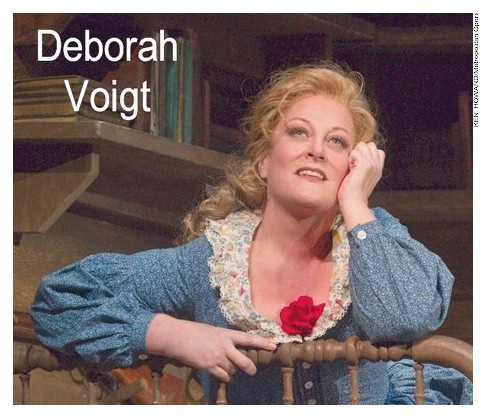 Simonetta Puccini, the composer's granddaughter, is expected to attend. Walfredo Toscanini, grandson of maestro Arturo Toscanini, who conducted the prem, will be in the audience. Tyne Daly, Angela Lansbury, and Dan Rather are among those expected on the red carpet.
Simonetta Puccini, the composer's granddaughter, is expected to attend. Walfredo Toscanini, grandson of maestro Arturo Toscanini, who conducted the prem, will be in the audience. Tyne Daly, Angela Lansbury, and Dan Rather are among those expected on the red carpet.
Fanciulla's final performance on January 8 telecasts to 1,500 cinemas worldwide via the Met's Live in HD series and will on the Toll Brothers-Metropolitan Opera International Radio Network.
Deborah Voigt, half the woman she used to be and absolutely mesmerizing, sings the title role of saloon owner Minnie, who's waiting in a lusty Gold Rush mining camp for true love. She first performed the role last summer at San Francisco Opera to rave reviews.Miss Voigt is famed for her portrayals in Wagner and Strauss operas, but doesn't "feel that huge vocal shifts are necessary to sing Puccini. I'm a singer who sings by sensation. If it feels good in Strauss or Wagner, it will feel good in Puccini." Of her character, she states, "Minnie is very chatty and there are enormous vocal leaps between intervals. She has a couple has a couple of really perilous high Cs that come out of nowhere. The word 'voice-wrecker' comes up a lot when people talk about Minnie's arias."
One reason for that, Miss Voigt says, "is because many women who sing the role come from more lyric Italian repertoire, so for them it's a hugely dramatic step."
Marcello Giordani, a vet Met tenor in numerous Puccini operas, is Dick Johnson/Ramerrez - the former, an adventurer who falls head over heels; the latter, an infamous thief on the run. Lucio Gallo is absolutely perfect as villainous sheriff Jack Rance, so madly in love with Minnie that he just pleads for one kiss even after she rejects and rejects his pursuit; and who will stop at nothing to arrest Johnson/Ramerrez.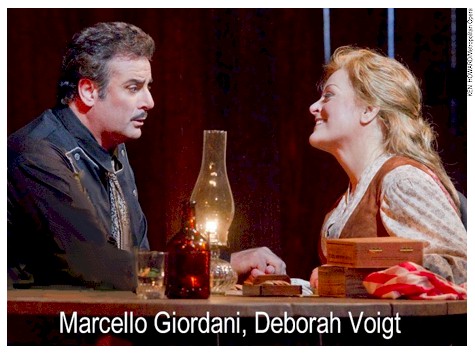 SFO's Nicola Luisotti, in his Met debut, conducts the massive Met orchestra. Giancarlo Del Monaco, son of legendary tenor Mario Del Monaco, returns to direct the revival of his 1991 production. Sets and costumes are by Michael Scott. The opera has a huge cast, all male except for Minnie and a "squaw," a Native American woman in a minor role.
SFO's Nicola Luisotti, in his Met debut, conducts the massive Met orchestra. Giancarlo Del Monaco, son of legendary tenor Mario Del Monaco, returns to direct the revival of his 1991 production. Sets and costumes are by Michael Scott. The opera has a huge cast, all male except for Minnie and a "squaw," a Native American woman in a minor role.
Elisabete Matos will make her Met debut as Minnie on December 22. Carl Tanner will make his as Dick Johnson/Ramerrez on December 27.Puccini based Madama Butterfly on Belasco's Madame Butterfly; so he was anxious to see Belasco's play The Girl of the Golden West [he also directed, produced, and designed the sets] at the Belasco during his first trip to New York in 1907 when it was revived briefly a year and a half after opening.
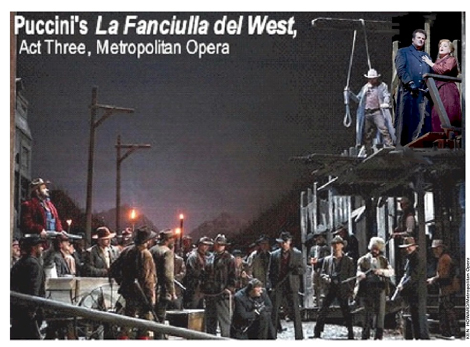 Fanciulla is richly melodic. I don't know if I'd buy what the composer told The New York Times on the occasion of Girl of the Golden West, as it was titled, in December 1910 at the first-ever world premiere at the Met. He said, "I consider this the best of my operas." That's saying something from the composer of La Bohème, Madama Butterfly, Manon Lescaut, Turandot, and Tosca. There were 55 curtain calls [a more recent number is 19] for Puccini, stage director Belasco; stars Emmy Destinn, Enrico Caruso, and Pasquale Amato; and Toscanini.
Fanciulla is richly melodic. I don't know if I'd buy what the composer told The New York Times on the occasion of Girl of the Golden West, as it was titled, in December 1910 at the first-ever world premiere at the Met. He said, "I consider this the best of my operas." That's saying something from the composer of La Bohème, Madama Butterfly, Manon Lescaut, Turandot, and Tosca. There were 55 curtain calls [a more recent number is 19] for Puccini, stage director Belasco; stars Emmy Destinn, Enrico Caruso, and Pasquale Amato; and Toscanini. 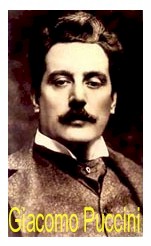 The libretto by Guelfo Civinini and Carlo Zangarini, who had never set foot in the U.S., is closely based on Belasco's play - perhaps, a little too closely. The lyrics often border the mundane, but Puccini's soaring score, one of his most beautiful, makes up for that. Fanciulla has a huge fan in Andrew Lloyd Webber and, as many know, he generously lifted several extensive motifs for Phantom of the Opera, especially the music for "The Music of the Night."
The libretto by Guelfo Civinini and Carlo Zangarini, who had never set foot in the U.S., is closely based on Belasco's play - perhaps, a little too closely. The lyrics often border the mundane, but Puccini's soaring score, one of his most beautiful, makes up for that. Fanciulla has a huge fan in Andrew Lloyd Webber and, as many know, he generously lifted several extensive motifs for Phantom of the Opera, especially the music for "The Music of the Night."
A world prem at the Met was big news. The opera was massively publicized and became a major society event with music lovers from around the world descending on New York.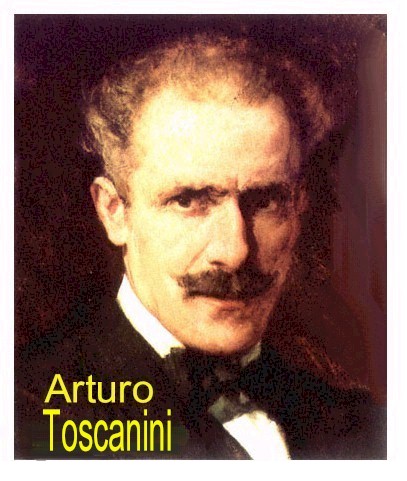 Walfredo Toscanini notes, "Preceding 1910, the Metropolitan has been challenged for musical supremacy by Oscar Hammerstein and his Manhattan Opera [which presented in what is now known as the Hammerstein Ballroom on West 34th Street at the read of the New Yorker Hotel]. Mr. Hammerstein imported acclaimed European sings and conductors and expanded the repertory with new operas.
Walfredo Toscanini notes, "Preceding 1910, the Metropolitan has been challenged for musical supremacy by Oscar Hammerstein and his Manhattan Opera [which presented in what is now known as the Hammerstein Ballroom on West 34th Street at the read of the New Yorker Hotel]. Mr. Hammerstein imported acclaimed European sings and conductors and expanded the repertory with new operas.
The arts patron Otto Kahn, a German-born financier, led the campaign to contemporize the Met, which he felt was too heavily influenced by German works. In quite a coup, he brought La Scala general manager Giulio Gatti-Casazza and my grandfather, its principal conductor, to the Met."Competition was fierce, he states, and "the popularity of both houses continued throughout 1009; but by the next year, Mr. Hammerstein could no longer meet his expenses and negotiated a surrender to the Met, a rare defeat for the impresario."
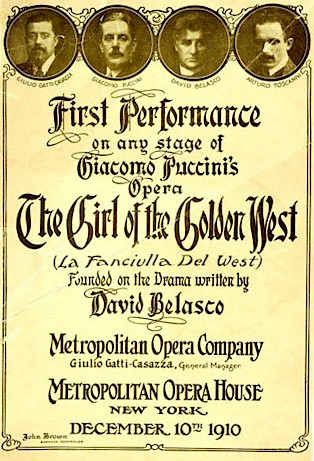 He wasn't the only one to stumble. Gatti-Casazza blundered in terming Girl "Puccini's American opera," which didn't sit well with the composer. He countered that the opera couldn't be called "American," because "music has no nationality. It is either music or nothing." However, he did point out that his score captured "the spirit of America and the vigorous nature of the West."
He wasn't the only one to stumble. Gatti-Casazza blundered in terming Girl "Puccini's American opera," which didn't sit well with the composer. He countered that the opera couldn't be called "American," because "music has no nationality. It is either music or nothing." However, he did point out that his score captured "the spirit of America and the vigorous nature of the West."Mr. Toscanini says, "There were distractions in Puccini's private life" - of a romantic nature. The composer had acquired substantial wealth and enjoyed his persona as a grand gentleman. He was a dedicated game hunter, car and motorboat collector, and quite open about his "appreciation for attractive women." He once stated, "I am almost always in love!" It didn't matter that the woman might be married, as was the case with Elvira Gemignani. Theirs was a stormy relationship that attracted massive gossip and could easily have been adapted into an opera. Miss Gemignani did run off with the composer, but they weren't married until some time after her husband's death.
That didn't end the scandal. She's reported to have "hounded a household maid with accusations of a liaison" with her husband. The girl committed suicide and Mrs. Puccini was jailed for five months. The couple separated, then reconciled, but it's noted that their relationship was forever damaged.
Things often got rocky with Toscanini. Their relations, says the grandson, "blew hot and cold." After one blow up, the composer forgot that he and the conductor were on the outs. One Christmas, he sent him an Italian pannetone [a cupola-shaped sweet cake made with raisins, candied orange, citron, and lemon zest]. Realizing his screw-up, he sent Toscanini a wire that read: Pannetone sent by mistake, Puccini. The conductor wired back: Pannetone eaten by mistake, Toscanini.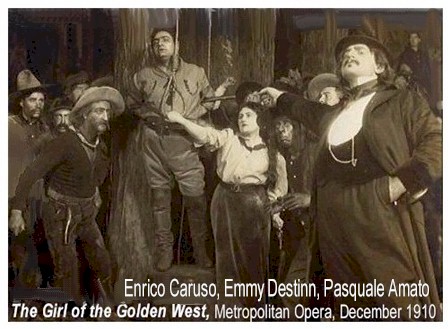 Now, back to the opera: Mr. Toscanni says, "Puccini wasn't pleased that the librettists weren't delivering what he wanted, but he composed full steam ahead. The orchestra score was delivered on time in October. My grandfather thought the opera has a great score. He called it 'a tone poem from beginning to end.'"
Now, back to the opera: Mr. Toscanni says, "Puccini wasn't pleased that the librettists weren't delivering what he wanted, but he composed full steam ahead. The orchestra score was delivered on time in October. My grandfather thought the opera has a great score. He called it 'a tone poem from beginning to end.'"He noted that as pleasant as his grandfather could be at home, he was a taskmaster when it came to work. "When he began to rehearse the orchestra and singers, he often marked the score where he felt it needed adjusting, especially to the acoustical qualities of the house. When Puccini arrived in November, a feverish collaboration existed between him, grandfather, Mr. Belasco, Mr. Caruso, Miss Destinn, and Mr. Damato for three weeks."
Mr. Toscanini noted that throughout rehearsals, Caruso drew hundreds of caricatures of his co-stars and his grandfather. "At the premiere," he says, "Puccini was acclaimed after ever act."
Destinn and Caruso repeated their performances for three consecutive seasons. By that time, however, critics began to savage Puccini for the opera's "inauthenticity." Some dismissed his work as overly impassioned, melodramatic, and sentimental. The Met never lost faith in Girl/Fanciulla and continued to revive it. It soon fell back in favor with audiences. Later productions starred Leontyne Price and Richard Tucker, Dorothy Kirsten and Franco Corelli. Renata Tebaldi performed Minnie in 1970, followed a year later with Plácido Domingo as Dick Johnson/Ramerrez.
La Fanciulla del West can be enjoyed via closed-circuit telecast in movie theaters, on radio, and internet streaming. The January 8 matinee will be transmitted to more than 1,500 cinemas in more than 40 countries as part of The Met: Live in HD series.
Performances on December 14 and 22, and January 3 and 8 will be broadcast live on Metropolitan Opera Radio on SIRIUS channel 78 and XM channel 79.
For ticketing, performance schedule, casting, backstories, interview video, and more information, visit www.metoperafamily.org.
Boston University is currently featuring Fanciulla 100: Celebrating Puccini in collaboration with the Howard Gotlieb Archival Research Center. It features original archival material entitled The Girl of the Golden West: Chronicling Puccini's Fanciulla, showcasing material from the Toscanini family, and from collections held at the Center and including the papers of Sarah Caldwell, Tito Gobbi, Dorothy Kirsten, Rise Stevens, Deborah Voigt, and others.For more information, visit www.fanciulla100.org or www.bu.edu/archives.
Literary Stocking StuffersWhat better way to spend the holiday season, when you've not volunteering at your house of worship's soup kitchen or some of the very worthy charity organizations, than to end your day snuggled in a Snuggie in front of your roaring fireplace with a good book.
Two hot theatrical tomes are:
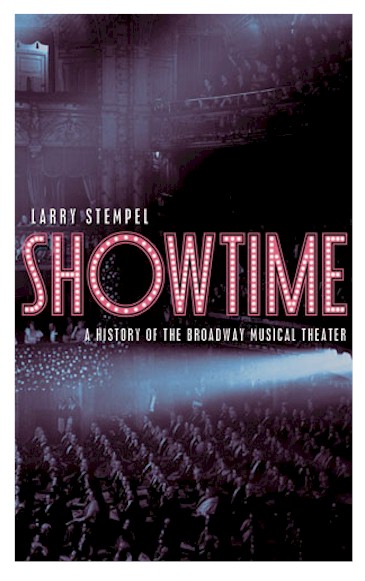 Get a heavy duty stocking for Larry Stempel's definitive, exhaustive history of the Bway musical - the shows, stars, movers, shakers, Showtime: A History of the Broadway Musical Theater [W.W. Norton, 826 pages, profusely illustrated with color and B&W photos, posters, sheet music, illustrations; 50-page Notes section, 37-page Works Sited section; Discography; Index; SRP $40].
Get a heavy duty stocking for Larry Stempel's definitive, exhaustive history of the Bway musical - the shows, stars, movers, shakers, Showtime: A History of the Broadway Musical Theater [W.W. Norton, 826 pages, profusely illustrated with color and B&W photos, posters, sheet music, illustrations; 50-page Notes section, 37-page Works Sited section; Discography; Index; SRP $40].The book weighs a ton. It's the culmination of decades of painstaking research by Stempel, an associate professor of music at Fordham University and a recipient of a National Endowment for the Humanities Fellowship. He covers a kaleidoscope of two decades.
His expansive take is certainly one of the most comprehensive, authoritative histories of the Bway musical, the performers who appeared in them and the creators who wrote and directed. hugely entertaining.
There are many details and vivid stories, but the book is vastly entertaining as he segues from vaudeville and operetta, through the Golden Age of musicals [Show Boat, Oklahoma, South Pacific, Carousel] to later groundbreaking works [ACL, Rent].
One huge problem in reading theater historian and critic Peter Filichia's account of 50 years of Bway hits and flops, Broadway Musicals: The Biggest Hit & the Biggest Flop of the Season, 1959 to 2009 [Applause Books; 277 pages; trade softcover; SRP $20]. It's all but impossible to get past the table of contents.Anyone who loves theater reads Filichia's columns on Theatermania.com is aware of his amazing knowledge, always presented in an engaging way, of everything theater and his witty way with words. The Table of Contents preps you for what's to follow, but it's such fun that it will take you a while to get to what follows.
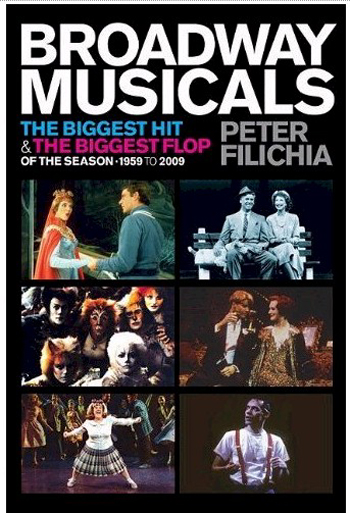 The lavishly illustrated Broadway: The American Musical [Applause Books; 498 pages, Updated edition; softbound, Show chronology; Bibliography; Theatre District maps 1928/2010; Index; Foreword by Julie Andrews; SRP $35], co-authored by Michael Kantor and NYU professor/theater historian Laurence Maslon and based on Kantor's 2004 documentary [originally a companion to the six-part PBS series] is the first comprehensive history of the musical, from its early 20th Century roots and into the new millennium.
The lavishly illustrated Broadway: The American Musical [Applause Books; 498 pages, Updated edition; softbound, Show chronology; Bibliography; Theatre District maps 1928/2010; Index; Foreword by Julie Andrews; SRP $35], co-authored by Michael Kantor and NYU professor/theater historian Laurence Maslon and based on Kantor's 2004 documentary [originally a companion to the six-part PBS series] is the first comprehensive history of the musical, from its early 20th Century roots and into the new millennium.Every season Broadway has one, two, or if really lucky three hit musicals, along with the one, two, or if really lucky three, four, or five flops.
Filichia chronicles what he calls the "extreme cases" from a half-century of shows that went from torturous out-of-town tryouts to Broadway previews and which, in a majority of cases, actually opened. Both categories have award winning composers, bookwriters, lyricists, producers, and A-List stars.Of the 100 musicals [and don't expect every hit or flop], there are those predicted to be hits; and those that sounded challenging or foolhardy, and dozens more. Also chronicled are the shows that had fingers crossed in hopes of becoming long run staples, those much-anticipated to be smashes because of the talent involved but weren't; and the wild cards that many thought daring, risky, iffy, or didn't have a chance.
Not every flop was a flop for obvious reasons. Many had merits, sometimes more merit than some of the shows that became hits. You may not agree with his Hit and Flop selections, but you'll enjoy the indefatigable research and how Filichia breezes through the decades with commentary from theater insiders, behind-the-scenes trials and tribulations, and the joy and despair of opening nights. He's often blunt and unforgiving [yet in a kind way], and not always about the flops.
There are two shortcomings: No inside photos, except for chapter pics of [probably] Filichia's ticket studs from each decade, or Index. However, the Table of Contents with its five sections covering 50 decades sort of subs for an Index.
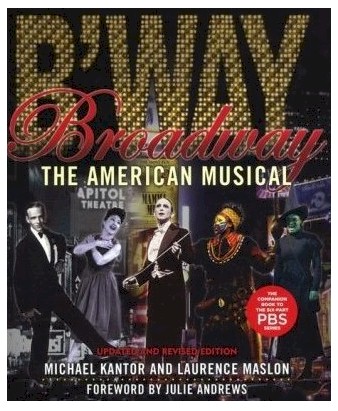 In addition to the six chapters covering 1893 - 2009, what makes the book a valued collectible is the treasure trove of photographs [many oversized and double-truck size], poster art, vintage Playbills, sheet-music covers, lyrics, scene design, production and rehearsal shots, excerpts from scripts, bios, even caricatures.
In addition to the six chapters covering 1893 - 2009, what makes the book a valued collectible is the treasure trove of photographs [many oversized and double-truck size], poster art, vintage Playbills, sheet-music covers, lyrics, scene design, production and rehearsal shots, excerpts from scripts, bios, even caricatures.Just as the PBS series did [hopefully, the network will repeat it soon], the book, weighing in excess of five pounds, brings alive the epic story of musical theater and its inextricable link to 20th and 21st-Century American life through portraits of the creative artists on and off stage who have defined theater.
When Florenz Ziegfeld arrived New York in 1893 to find acts for the Chicago World's Fair, Broadway and 42nd Street was no one's idea of "the crossroads of the world." In fact, there were no theatres North of the intersection. In the famed tradition of Build-it-and-they will come, with the New Amsterdam Ziggy found the magic formula: music, spectacle and sex appeal. By 1913, his Follies had become an amalgamation of everything that was happening in America.
Peppered throughout B:TAM are such historical moments such as Gershwin's visit to Folly Island, SC, where he began to compose Porgy and Bess; the decline of operetta and revues and the introduction of book shows that touched on social issues, such as Show Boat, South Pacific, Oklahoma!, and West Side Story; and as the book reaches the latter part of the 20th Century, the impact of Herman, Sondheim, and Lloyd Webber.
Sidebars highlight the stars, shows, composers [Sondheim on Kern, Hart on Rodgers], and tunes that made the musical great; original cast albums; and many lesser known shows.
Broadway: The American Musical is still available in a DVD boxed-set [PBS/Paramount Home Entertainment; six hours; SRP $50] and as a five-CD package [Sony/Columbia Masterworks; SRP $60].
Evenings of Whining and Kvetching Jackie Hoffman just loves working ... and hollering. Through the holiday season, her Monday nights off [and Christmas and New Year's Eve] from The Addams Family will be spent providing lusty topical humor of the adult kind at Joe's Pub [through January 17] with additional performances of her hilarious whinefest Jackie Five-Oh!, which she co-wrote with Michael Schiralli.
Jackie Hoffman just loves working ... and hollering. Through the holiday season, her Monday nights off [and Christmas and New Year's Eve] from The Addams Family will be spent providing lusty topical humor of the adult kind at Joe's Pub [through January 17] with additional performances of her hilarious whinefest Jackie Five-Oh!, which she co-wrote with Michael Schiralli.Hoffman, who just finished celebrating all eight days of Chanukah, unflinchingly skewers sacred cows such as the Tonys and Holocaust movies [however, she would like to star in a Holocaust musical], flings acid barbs at the Broadway hierarchy, and does painfully accurate imitations of a gallery of showbiz icons.
Some ROTF moments come when she muses on her decay now that she's over the hill at age 50, kvetches bitterly of a career playing bit parts [Xanadu, Hairspray], not having a solo number in TAF [she says the only reason her character of Grandma is onstage in the second act is because they needed someone front of curtain while sets were changed], Queen Latifah [for "stealing" a film role she was set to play and thus denying her her SAG health insurance], and Bway's li'l darlin' Kristen Chenoweth.It's her show and she can sing if she wants to; and she wants to. Songs are by Hoffman and Bobby Peaco, who also music directs. Schiralli directs.
When she's not at the Lunt-Fontanne, Joe's Pub is her second home. Her one-woman Chanukah at Joe's Pub won a Bistro Award. Oh, did I mention she has a new CD? If not, she will!
Tickets are $30 and available by calling (212) 967-7555 or visiting www.joespub.com. Shows are at 7:30, except 7 P.M. on New Year's Eve.
Leslie Uggams SRO in PasadenaYou might call Leslie Uggams the girl of the golden west, as she's become the good luck charm of the revitalized, reopened Pasadena Playhouse. After weeks of SRO in Stormy Weather, the Lena Horne bio musical, Tony winner Uggams is back in Uptown Downtown, directed and conceived by Michael Bush [who helmed S.W.]. This is the final weekend for the autobiographical revue, a virtual musical history of Uggams 50 years in show business.
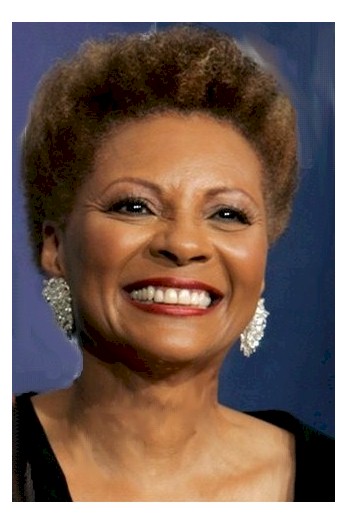 "You could call the show the journey of my life and career," says Ms. Uggams. "It's very autobiographical. It's an extension of what started one night last February at the Allen Room and my Jazz at Lincoln Center American Songbook concert. There are songs from uptown in Harlem when I appeared with some of the greats at the Apollo, and downtown in the theater district. The stories involve my early days in TV, then with Mitch Miller, and, of course, on down to my role in the groundbreaking miniseries Roots."
"You could call the show the journey of my life and career," says Ms. Uggams. "It's very autobiographical. It's an extension of what started one night last February at the Allen Room and my Jazz at Lincoln Center American Songbook concert. There are songs from uptown in Harlem when I appeared with some of the greats at the Apollo, and downtown in the theater district. The stories involve my early days in TV, then with Mitch Miller, and, of course, on down to my role in the groundbreaking miniseries Roots."At this point in her career, you would think there would be no surprises. Ms. Uggams has literally seen it all, "but I'm surprised that many folks have forgotten how young I was when I started in the business." She was eight!
Songs include "There's a Boat That's Leavin' Soon for New York," "Summertime," and "I Got Plenty o' Nothin' [Porgy and Bess]; "New York, New York"; "If He Walked into My Life" [Mame]; "My Own Morning" and "Being Good" from her award-winning role in Hallelujah, Baby; the torch classic, "Stormy Weather"; and the show's standout moment, an autobiographical adaptation of "Born in a Trunk," the Garland showstopper from A Star Is Born, to introduce her years as a child star and singer in Harlem clubs, at the Apollo, where she had memorable run-ins with Louis Armstrong, Billie Holiday, Ella Fitzgerald, and Dinah Washington, and on TV.
Asked how she keeps those "pipes" so pristine, Ms. Uggams replied, "I just respect them and take care of them." She and husband Grahame live in the Theatre District and it's hard, she says, "not to dream of being back on Broadway. We still hope we'll be able to bring Stormy Weather in. Hope being the optimum word. As you know, everything's changed."Tickets and information are available 24 hours online at www.Pasadenaplayhouse.org.
King Tut Times Square Reign Ends Soon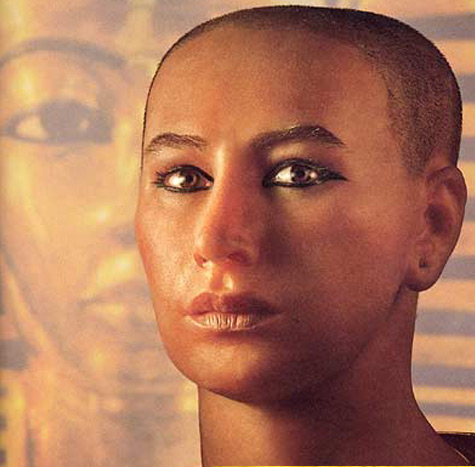 The spectacular Tutankhamun and the Golden Age of the Pharaohs runs at Discovery Times Square Exposition through January 2011. There are more than 130 treasures from Tut's burial chamber other 18th Dynasty Valley of the Kings tombs.
The spectacular Tutankhamun and the Golden Age of the Pharaohs runs at Discovery Times Square Exposition through January 2011. There are more than 130 treasures from Tut's burial chamber other 18th Dynasty Valley of the Kings tombs.
According to Dr. Zahi Hawass, Secretary General of Egypt's Supreme Council of Antiquities, this is the last opportunity to view the treasures outside of Cario. After New York, the reign of King Tut will end here and return to Egypt to new Tutankhamun Grand Museum. Hawass oversees all Egyptian archaeological projects [he supervised the major restoration of the Great Sphinx]. There are over 50 objects from Tut's tomb. Only a handful have been seen before. Among them is a restored chariot believed to have been used by the boy king, who reigned for nine years before his death at 19 from a concussion received in battle, malaria, or bone disease.
There are over 50 objects from Tut's tomb. Only a handful have been seen before. Among them is a restored chariot believed to have been used by the boy king, who reigned for nine years before his death at 19 from a concussion received in battle, malaria, or bone disease.
Archeologist Howard Carter uncovered the remarkably preserved Tut tomb in 1922, creating worldwide headlines. It's the only tomb of its era found with treasures intact. Along with the discovery came claims of a curse, which helped make Tut one of the most popular Egyptian pharaohs. The exposition - organized by National Geographic, and Arts and Exhibitions International with cooperation from Northern Trust and American Airlines - is in the bowels of what was once the printing plant of the former NYTimes , a massive space that's been rehabilitated to house major touring exhibits.
The exposition - organized by National Geographic, and Arts and Exhibitions International with cooperation from Northern Trust and American Airlines - is in the bowels of what was once the printing plant of the former NYTimes , a massive space that's been rehabilitated to house major touring exhibits.
Tickets are $27.50, adults; $25.50, seniors; $17.50, children four - 12. There's the Family Pack [two adults, two children ages 4-12] for $79. Special group pricing is available. To purchase, visit the Exposition box office or online at www.kingtutnyc.com, or call (888) 988-8692.
A Remastered Trove of Film Scores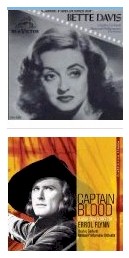
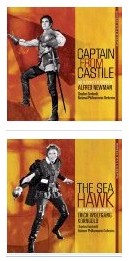 Just in time for the holidays, there's a feast for film buffs in the reissue of a treasure trove of classic film scores remastered for CD from the original analog and stereo tapes.
Just in time for the holidays, there's a feast for film buffs in the reissue of a treasure trove of classic film scores remastered for CD from the original analog and stereo tapes.
Each contains a photo book containing the original liner notes [Sony Masterworks; SRP, approximately $12 and change]. The huge undertaking, originally on RCA Red Seal, features Charles Gerhardt, using the original orchestrations, conducting a full symphony orchestra.
Among the titles are suites of sweeping themes from such master composers as Alfred Newman, Erich Wolfgang Korngold, Max Steiner [including an album of his complete Gone with the Wind score], and Dimitri Tiomkin. The films of Humphrey Bogart, Bette Davis, Errol Flynn, and Tyrone Power are among those featured.Luxury Travel from Your Chair
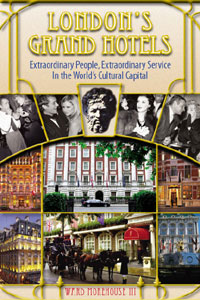 Ward Morehouse III has long had a love affair with grand hotels of the world. The first he wrote about, that historic gem on Park Avenue, where royalty, presidents, and stars have stayed, was chronicled in The Waldorf-Astoria: America's Gilded Dream. Morehouse was indoctrinated into the glam life of luxury hotels as a youth traveling with his father, the late drama critic Ward Morehouse, who loved the hotel life to the degree that he requested "Room service, please!" on his grave marker.
Ward Morehouse III has long had a love affair with grand hotels of the world. The first he wrote about, that historic gem on Park Avenue, where royalty, presidents, and stars have stayed, was chronicled in The Waldorf-Astoria: America's Gilded Dream. Morehouse was indoctrinated into the glam life of luxury hotels as a youth traveling with his father, the late drama critic Ward Morehouse, who loved the hotel life to the degree that he requested "Room service, please!" on his grave marker.
In London's Grand Hotels -- Extraordinary People, Extraordinary Service, in the World's Cultural Capital [BearManor Media; softbound, 308 pages, 16-page B&W gallery; Index; SRP, $25], Morehouse goes beyond fine linens and fancy uniforms and exposes the escapades of A-List celebrities [Laurence Olivier and Vivian Leigh, Humphrey Bogart and Lauren Bacall, and Liz and Dick, to name a few] who made Brown's, the Claridge, Savoy, May Fair, Grosvenor House, and the Dorchester their home away from home.Ellis Nassour is an international media journalist, and author of Honky Tonk Angel: The Intimate Story of Patsy Cline, which he has adapted into a musical for the stage. Visit www.patsyclinehta.com.
He can be reached at [email protected]
Why are you looking all the way down here?
For more articles by Ellis Nassour, click the links below!
Previous: Richard Dreyfuss Retired from Acting; Encores! Rings in New Season; Arresting Dramas; Puccini Celebration; Harry Potter, the Beginning of the End; More
Next: The Holidays Are Upon Us! The Rockettes and Christmas; Kennedy Center Honors on CBS; Theater Hall of Fame; Stocking Stuffers; Karen Ziemba; Arresting Performances; The Met Telecasts Girl of the Golden West; More
Or go to the Archives
[Broadway Ad Network]
[Broadway Ad Network]

If you would like to contact us, you can email us at feedback@
broadwaystars.com
[Broadway Ad Network]
[Broadway Ad Network]

- July 15: Harry Connick, Jr. in Concert on Broadway - Neil Simon
- Sept. 28: Brief Encounter - Studio 54
- Sept. 30: The Pitmen Painters - Samuel J. Friedman Theatre
- Oct. 3: Mrs. Warren's Profession - American Airlines Theatre
- Oct. 7: Time Stands Still - Cort Theatre
- Oct. 12: A Life In The Theatre - Schoenfeld Theatre
- Oct. 13: Bloody Bloody Andrew Jackson - Bernard Jacobs Theatre
- Oct. 14: La Bete - The Music Box Theatre
- Oct. 21: Lombardi - Circle In The Square
- Oct. 25: Driving Miss Daisy - John Golden Theatre
- Oct. 26: Rain - A Tribute To The Beatles On Broadway - Neil Simon Theatre
- Oct. 31: The Scottsboro Boys - Lyceum Theatre
- Nov. 4: Women On The Verge Of A Nervous Breakdown - Belasco Theatre
- Nov. 9: Colin Quinn Long Story Short - Helen Hayes Theatre
- Nov. 11: The Pee-Wee Herman Show - Stephen Sondheim Theatre
- Nov. 13: The Merchant of Venice - The Broadhurst Theatre
- Nov. 14: Elf - Al Hirschfeld Theatre
- Nov. 18: A Free Man Of Color - Vivian Beaumont Theater
- Nov. 21: Elling - Ethel Barrymore Theatre
- Dec. 9: Donny & Marie: A Broadway Christmas - Marquis Theater
- Jan. 13: The Importance of Being Earnest - American Airlines Theatre
- Mar. 3: Good People - Samuel J. Friedman Theatre
- Mar. 6: That Championship Season - Bernard B. Jacobs Theatre
- Mar. 11: Kathy Griffin Wants a Tony - Belasco
- Mar. 17: Arcadia - Barrymore Theatre
- Mar. 20: Priscilla Queen Of The Desert The Musical - The Palace Theatre
- Mar. 22: Ghetto Klown - Lyceum Theatre
- Mar. 24: The Book Of Mormon - Eugene O'Neill Theatre
- Mar. 27: How To Succeed In Business Without Really Trying - Al Hirschfeld Theatre
- Mar. 31: Bengal Tiger at the Baghdad Zoo - Richard Rodgers Theatre
- Apr. 7: Anything Goes - Stephen Sondheim Theatre
- Apr. 10: Catch Me If You Can - The Neil Simon Theatre
- Apr. 11: The Motherf**ker with the Hat - Gerald Schoenfeld Theatre
- Apr. 14: War Horse - Vivian Beaumont Theater
- Apr. 17: Wonderland: A New Alice. A New Musical Adventure. - Marquis Theatre
- Apr. 19: High - Booth Theatre
- Apr. 20: Sister Act - The Broadway Theatre
- Apr. 21: Jerusalem - Music Box
- Apr. 24: Born Yesterday - Cort Theatre
- Apr. 25: The House of Blue Leaves - Walter Kerr Theatre
- Apr. 26: Fat Pig - Belasco Theatre
- Apr. 27: Baby It's You! - Broadhurst Theatre
- Apr. 27: The Normal Heart - Golden Theater
- Apr. 28: The People in the Picture - Studio 54
- Apr. 28: The End of The Season
- Jun. 12: The 65th Annual Tony Awards - Beacon Theatre
- June 14: Spider-Man, Turn Off The Dark - Foxwoods Theater
- June 21: Master Class - Samuel J. Friedman

